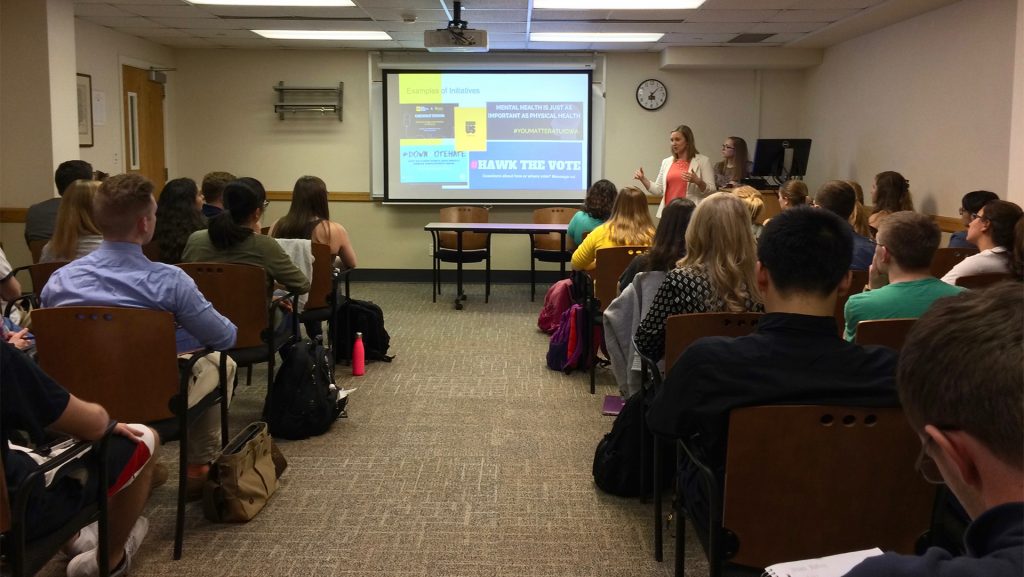As students will soon elect their new leaders in the University of Iowa Student Government, The Daily Iowan broke down how current UISG leaders handle the organization’s $1.872 million budget it shares with the Graduate & Professional Student Government.
Every student pays $72 as part of a student activity fee each year. This money makes up the two student governments’ budget. The state Board of Regents, which governs the three public universities in Iowa, approves the student activity fee for each school.
In recent years, UISG has gotten back nearly half of the the funds it gives student organizations, prompting UISG Director of Finance Jeremy Vogel and UISG Sen. Sara Bultsma to re-examine how efficiently UISG distributes money.
“We realized there was a systemic problem, and if we continued to pour money into a broken system, it was just going to bring it back to us again anyway,” Bultsma said.
Student government first prioritizes part of its budget for wide-reaching student organizations such as Homecoming, Bijou, the Food Pantry, and the Rape Victim Advocacy Program.
The remaining dollars are then split between UISG and GPSG to fund their respective initiatives voted on by the student Senate. Approximately 77 percent goes to UISG and the remainder funds GPSG (23 percent).
UISG then directs money to student organizations that apply for funding during four “funding periods” throughout the school year, and the remaining unused funds go into a contingency account. The Student Allocation, Budgeting, and Auditing Committee makes student-organization funding decisions for UISG.
“We have a large budget, and it’s ultimately UISG’s main position to empower students in using that money, allocating it fairly, and making it as accessible as possible,” Bultsma said. “It’s student dollars, and they should be able to use them.”
However, UISG is making budget changes to encourage more efficient spending after several years of student organizations returning high rates of funds.
Last fall, approximately 50 percent of funds approved for student organizations went unused and were returned to UISG at the end of the semester, adding to its contingency account, where leftover money accumulates to fund UISG initiatives.
Last spring, a total of $145,199 was returned from both semesters, inflating the contingency account to more than three times the maximum funding amount at the start of the 2017-18 school year.
This prompted Vogel and Bultsma to take a look at why student organizations weren’t using the money they asked for.
The pair learned student leaders found the application confusing, leading them to apply for too much funding or insufficient funds, which caused the organization to cancel events and return the money to UISG.
The pair said they aim to start accepting funding applications biweekly instead of four times a year, as in the current process. Vogel said the change would allow UISG to work more closely with student groups to ensure they get the funds they actually need and guide leaders on how to spend wisely.
“We will hopefully be looking at a smaller batch of applications, and we will be able to give a more detailed examination of each application,” Vogel said.
President of Active Minds Sammy Stoll said the group has worked closely with UISG to make the funding application process less confusing.
“I can still say I always feel a little clueless regarding funding even though I have done it myself and even purchased services for events and gotten reimbursed for them,” Stoll said in an email to the DI. “My experience has always been guessing what to do and asking questions the entire way.”
Editor in Chief of Fools magazine Madeline Smith said she completed a funding application process for the first time this spring since for an easier, one-time funding application, because it was simpler than applying for a funding period in the fall of 2016 when the magazine was founded.
Editor’s note: Smith was a reporter for the DI in the spring of 2016.
“We had applied for the funding periods before, and we never got any substantial amount of money that would help us or benefit us,” Smith said. “So we just took other routes to get money, we asked for more money from our sponsors or we would encourage student [organization] fees.”
The unused money from student groups are called “reversions” and are added to UISG’s contingency account at the end of the year. The account keeps a balance between $60,000 and $120,000 by the end of the year to act as emergency reserves.
At the start of this school year, fiscal 2018, the UISG contingency account had $375,950.51, Vogel said. After several UISG-funded projects, including the Hawkeye Retention Grant and the First Generation Summit, the budget is on track to reach $96,000 by the end of the year.



